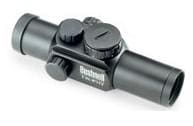
Red-dot & reflex scopes are handy. Highly-visible reticle, fast acquisition with both eyes open, great for low-light conditions. Recently they have gotten even better, with adjustable reticle patterns, dual-color reticles, and even a variable-size reticle model from Bushnell. But red-dot scopes have a weakness: battery power. Most people who use red-dot scopes have had a battery die on them. Hopefully they had a spare battery handy. If not, good luck hitting the target with no reticle to aim with. Trijicon and other companies have attempted to deal with the battery issue by powering their scopes with tritium capsules and/or fiber-optics . . .
Fiber optics work great during the day, but since there is little ambient light at night, another method of illumination is needed. Tritium is a radioactive gas, and it is not a perfect solution for illuminating a reticle because it only offers limited brightness, and tritium will get dimmer over time (half-life of 12.5 years). As long as the tritium is fresh, a fiber optic/tritium scope like the Trijicon ACOG is very effective. But these scopes are expensive. And once the tritium has decayed to half of its original luminosity, it will be harder to use effectively in low-light conditions, especially in dawn/dusk transitions when the fiber-optics cannot gather enough light.
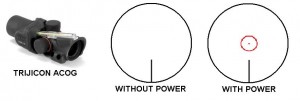
Trijicon also designed a Tripower scope which adds battery power to the tritium and fiber-optic systems. While that compensates for tritium that dims over time, you are still tied to the battery leash. No battery = no reticle.
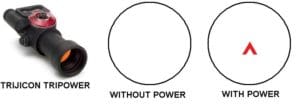
Yes, the 12.5 year half-life of tritium is a long time. But that clock starts ticking when the tritium is created, not when the manufacturer built the scope, and not when you buy the scope. For those people who plan on keeping their guns for a long time, that expiration date is a concern. While that may not be a concern for military/police users who have their old equipment replaced regularly, civilian users who pay for their own gear might not like the prospect of having to replace or service their scopes down the road.
Leupold created a new type of scope called a Prismatic scope which uses a unique reticle system which directly addresses the reticle-illumination issue. They have a few different versions, with retail prices of about $500. I mounted a Prismatic scope on a rifle, and did some comparisons with a rifle that has a traditional red-dot scope.
Leupold builds nice stuff, and the Prismatic isn’t cheap. The Prismatic scope is 4-3/8″ long; it has the thickest tube Leupold has ever made, and they claim it is practically indestructible. A rail-mounting bracket is included, along with 3 different risers. The battery-operated illumination module is included as well. It mounts to the Prismatic scope like a scope-ring would, and uses a small N-size battery.
Optically, the Prismatic scope is as sharp as a tack, and about as bright as viewing with the naked eye. There is no magnification whatsoever (unlike some “1x” scopes), and it is easy to keep both eyes open while taking aim. The ocular lens is large, and you don’t lose a lot of forward vision because of non-optical components around the ocular lens. The reticle is a “Circle-Plex”. It is etched into glass and permanently visible. When lighting conditions get iffy, you can activate the illuminator and the reticle lights up in red. But you always have the etched reticle to rely on. Click the picture to get a good look:
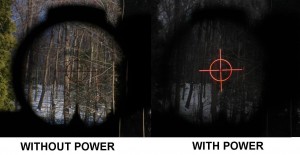
Now let’s look at a traditional red-dot; a Bushnell Trophy with 4 selectable red reticles to choose from.
Retail is usually about $90. As long as you have battery power, you have a reticle to aim with. But if your battery dies, you are up the creek without a paddle. The optics are of a smaller diameter than the Prismatic, so you have a narrower field of view. And, the optics are surrounded by a lot of metal, so you lose a little of your forward vision. Click for a bigger view:
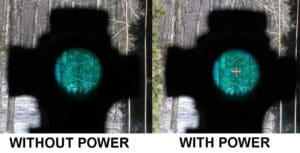
The difference isn’t just build quality. The Leupold is a better, more advanced design. I am not aware of any other scope with this reticle system. Aligning the etched reticle and the illumination system takes precision and that is not cheap. And with a permanent daytime reticle, a dead battery will not render your gun useless. That may not be a factor on a range toy, but if you plan on relying on a scoped gun to protect yourself, what price do you put on peace of mind? Murphy’s Law affects us all.
Your mileage may vary, but I am convinced. The Leupold Prismatic is not cheap, but you get what you pay for. Seeing the optical quality, knowing that it’s tough enough to last and having the reassurance of never having to rely on a battery is worth the investment to me. The Prismatic is staying on my SHTF long-gun.

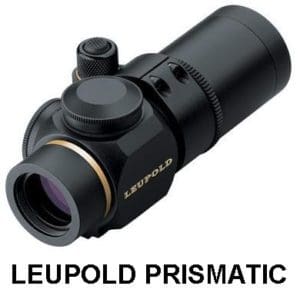
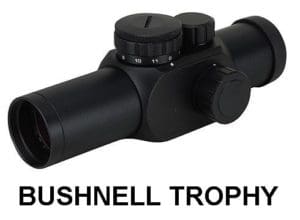



Unfortunately, like most things, no red dot is perfect. To, me the Aimpoint’s come the closest. Their M4, M3 and T1 models measure battery life in years. At about 80%, they are rated for about 6, 5, and 4 years when run continuously.
The problem with any sight that relies on ambient light such as the tri-power, is that it is possible to be in an area much lower in ambient light than the target and have the reticule wash out. Another issue with the Tri-power is when using the tritium illumination the reticle is nearly impossible to see–should have been called the dual power.
During daylight, the Prismatic’s black etched reticle is easy to see, unless against a black target. Lumination by its battery only lasts a handful of hours.
Some people prefer the large, double reticle of the Eotech over a single red dot, some don’t. Their history has been plagued with reliability issues and they turn off every 4 hours automatically from the last time they were turned on or adjusted. I prefer my equipment not to make its own decisions.
What do you think of the C-More?
Just a note – I’m pretty sure you can set all EOTechs to an 8 hours turn-off. Sure, it is still turning off after 8 hours, but it is 8 hours and turning it back on, or resetting the internal timer, is a matter of pushing a button.
I believe you are right. If my corrected memory serves, it depends on how you turn it on.
Either way, I still prefer to make my own decisions. I don’t want to have to remember to push a button to keep it turn on nor worry if it is on or not when I need it. Eotech calls it a “feature”, I call it a mistake
I have not heard good things about their reliability so I never tested the C-More myself. I have seen them on lots of competition guns, but never on tactical guns.
typo on my first text. “At about 80%,” should have read: “At about 80% brightness,”
The Russian PK-AS red-dot sight also features an etched circle and dot reticle, and has been around for a few years. Russian military optics lack the refinement (and warrantees) of better domestic and European makes, but they’re half the price and built like T-72 tanks.
Half the price and built like tanks are great features! Wouldn’t mind trying one.
My old eyes need high magnification for targets at 50 yards or so. Do any multipliers work well with these sights or should I stick to conventional scopes?
Prismatic in use at a convention: http://www.youtube.com/watch?v=SrsBUDgtbc4
The simplicity of the Prismatic is what appealed to me. I never have to hit a button to have a reticle. I have heard the battery life at maximum brightness is 10 hours at moderate temperature and 4 hours in extreme cold.
The Russian stuff is cheap, but the adjustments are vague and optically they do not perform as well as Japanese scopes [narrower field of view, etc]. And they tend to be heavier.
Can you please recommend a red dot type of sight that will not wash out in bright sunlight? i live in AZ and most them appear useless during the day. If it is possible I would like to stay with something moderately priced.
Thank you.
ULTRADOT I use them in southern Nevada in the middle of the summer and they are extremely bright. Tested mine with shotgun slugs, and they keep their zero perfectly well. They are made in Japan. Very good quality. Expect to pay about $250 for one with variable reticles.
Red Dot Sights Products including Top Brands like Vortex, Leupold, Trijicon, OpticsPlanet and More! OpticsPlanet is the top online source for all red dot scopes, holographic sights and reflex sights.
Comments are closed.